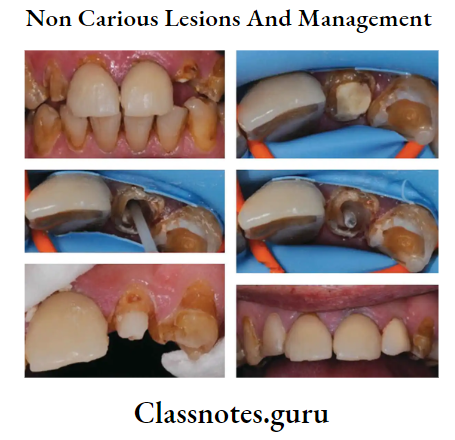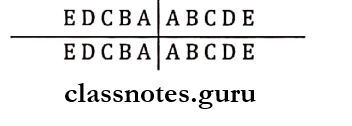Miscellaneous Long Essays
Question 1. Discuss various restorative materials used to restore Class 2.
Answer:
Various Restorative Materials Used To Restore Class 2:
Various Restorative Materials Used To Restore Class 2 Materials Used:
- Composites
- Amalgam
- Direct filling gold
- Metal inlay
1. Composite:
Composite Definition:
- Composite is a compound composed of at least two different materials with properties that are superior or intermediate to those of an individual component
Composition:
- Organic matrix BisGMA or UDMA
- Fillers Silica, barium. Zinc, Zirconium
- Coupling agents organic silane
- Coloring agents Titanium oxide
- UV Absorber Benzophene
- Initiator Camphoroquinone
- Inhibitor Butylated hydroxyl toluene
Composite Properties:
- High coefficient of thermal expansion
- Composites with higher filler content exhibit lower water absorption
- Wear resistant
- Radiolucent
- Low modulus of elasticity
Read And Learn More: Operative Dentistry Short And Long Essay Question And Answers
- Water solubility 0.51.1 mg/cm2
- Polymerization shrinkage
- Esthetics
- Microleakage
- Biocompatible
2. Amalgam:
- Amalgam Composition:
- Alloy:
- Mercury
- Silver 40%
- Tin 32%
- Copper 30%
- Zinc 2%
- Indium traces
- Amalgam Mercury:
- Properties:
- Initially, a small amount of contraction followed by expansion
- Amalgam has a maximum compressive and tensile strength
- Creep It is a time-dependent response
- It leads to marginal deterioration
- Amalgam shows tarnish and corrosion
- Amalgam needs pulpal protection
- Amalgam transmits temperature changes
- It has a high coefficient of thermal expansion
- Microleakage
- Properties:
- Alloy:
3. Direct Filling Gold:
Direct Filling Gold Properties:
- Cohesiveness
- Softness during manipulation
- Malleability and ductility
- Brinell hardness number 25
- Tensile strength 19000 psi
- The coefficient of thermal expansion is 14.4 x 106/°C
- High thermal conductivity
- The density of gold is 19.3 gm/cm3
Direct Filling Gold Types:
- Gold Foil:
- Sheets
- Gold foil cylinder
- Gold pellets
- Platinized gold foil
- Corrugated foil
- Laminated foil
- Crystalline Gold:
- Mat gold
- Mat foil
- Electrically
- Powdered Gold:
4. Metal Inlay:
Metal Inlay Definition:
- Inlay is an indirect intracoronal restoration that is fabricated extra orally and cemented in the prepared tooth
Metal Inlay Advantages:
- Better reproduction of details
- More wear resistance
- Biocompatible
- Strengthen the weakened remaining structure
- Less chair side
- Less chances of voids
- Easy to polish
Metal Inlay Disadvantages:
- Require temporary restoration
- Expensive
- Technique sensitive
- Difficult to repair
- Weak bonding to tooth structure
- Unaesthetic

Miscellaneous Short Essays
Question 1. Interim restoration.
Answer:
Interim Restoration:
Objectives:
- Maintain esthetics
- Act as space maintainers
- Allow functioning
- Determine occlusion
- Establish phonetics
- Seal and insulate the prepared tooth
- Prevent passive eruption of the tooth
- Prevent pathologic migration
Interim Restoration Requirements:
- Good marginal adaptation
- Optimal strength
- Plaque resistant surface
- Economical
- Easy to manipulate
- Dimensionally stable
Interim Restoration Purpose:
- Pulp protection
- Act as a sedative
- Soft tissue protection
- Protect weakened tooth protection
- Maintain the aesthetics
Interim Restoration Materials Used:
1. For Intra coronal preparation
- Guttapercha
- Zinc oxide eugenol
- Zinc phosphate
- Zinc polycarboxylate
- Glass ionomer
- Calcium hydroxide
2. For extra coronal
- Polycarbonate crowns
- Aluminum cylinder
- Stainless steel crowns
- Celluloid crowns
- Indirect acrylic restorations
Question 2. Resin Cement.
Answer:
Resin Cement:
Resin Cement Uses:
- For cementation of inlays/onlays
- For cementation of crown and bridge
- For bonding amalgam restoration
- For cementation of orthodontic brackets
- For cementation of endodontic posts
Resin Cement Types:
- Unfilled resin cement
- Filled resin cement
Resin Cement Available Forms:
- Powder and liquid
- 2 paste system
- Single paste with accelerator
Resin Cement Composition:
- Powder:
- Resin Matrix
- B1SGMA
- TEGDMA
- Fillersilica
- Zirconia
- Coupling Agent
- Organosilane
- Initiator And Activator
- Resin Matrix
- Liquid:
- Adhesive HEMA:
- Initiator:
- Benzoyl peroxide
- Inorganic Fillers:
- Silica
- Zirconia
- Means Of Polymerisation:
- Chemical cure
- Light cure
- Dual cure
- Commercial Names:
- PanaviaEx
- RelyX
- ARC Resin cement
- Commercial Names:
- Means Of Polymerisation:
Miscellaneous Short Answers
Question 1. Temporary restorative materials.
Answer:
Temporary restorative materials:
Temporary restorative materials is restoration given to the prepared tooth for the period between tooth preparation and cementing the restoration
Temporary restorative materials Features:
- Nonirritating
- Esthetics
- Easy to clean
- Maintain periodontal health
- Adequate strength and retention
Question 2. Secondary Dentin.
Answer:
Secondary Dentin:
- Secondary dentin is formed after the completion of root formation
- The direction of dentinal tubules is more asymmetrical and complicated
- Secondary Dentin is formed at a slower rate
Question 3. Tertiary Dentin/Reparative dentin.
Answer:
Tertiary Dentin:
- Tertiary Dentin is formed as a response to external stimuli
- Tertiary Dentin is irregular, with cellular inclusions
- Its tubular pattern ranges from an irregular to a tube-lar nature
- Reparative dentin has decreased permeability
- Tertiary Dentin is formed by secondary odontoblasts which are differentiated from mesenchymal cells of the pulp
- Reparative dentin helps in the prevention of diffusion of noxious agents from the tubules
Question 4. Universal Operator position.
Answer:
Universal Operator Position:
- 11 clock is considered a universal operating position
Position:
- The dentist sits behind slightly to the right of the patient and the left arm is positioned around the patient’s head.
Universal Operator Position Advantages:
- Most areas of the mouth are accessible from this position either using direct/indirect vision
Universal Operator Position Working Areas:
- Palatal and incisal/occlusal surfaces of maxillary teeth
- Mandibular teeth
Question 5. Transillumination and Magnification.
Answer:
Transillumination:
- Used for detection of caries
- Based on the difference in the refractory index of carious and sound normal tooth
- Carious tooth appears as a dark shadow when compared with the normal tooth
Magnification:
- Devices:
- Loupes
- Surgical telescopes
- Bifocal eyeglasses
- Advantages:
- Increases visibility of the operating area
- Easy to perform the delicate procedure
- Increases operator’s efficiency
- Protects eye from injury
Question 6. Soldering.
Answer:
Soldering:
- Soldering is the process of joining two metals together by adding the third metal
- The soldered metal should have a melting point equal to or lower than the two metals
- To increase the flow of solder, flux is added to it
- However, too much of flux leads to the flowing away of solder
- This is prevented by the addition of antiflux.
Question 7. Surface Hardness.
Answer:
Surface Hardness:
- Surface Hardness is the property that is used to predict the wear resistance of a material and its ability to abrade opposing dental structures
- Various hardness tests are used to determine the hardness of different dental materials
- They are
- Brinell hardness test
- Rockwell hardness test
- Knoop hardness test
Question 8. Modulus of elasticity
Answer:
Modulus Of Elasticity Definition:
- Modulus Of Elasticity is the relative stiffness or rigidity of material within the elastic range
Modulus Of Elasticity Measurement:
- Modulus Of Elasticity is the ratio of stress to strain and is described as E
Modulus Of Elasticity Importance
- Modulus Of Elasticity indicates that the less the strain, the greater will be the stiffness
- Elastic modulus has a constant value
- Modulus Of Elasticity is not affected by the amount of plastic and elastic stress that is induced in the material
- The modulus Of Elasticity is independent of the ductility of the material
- The modulus of elasticity of enamel and dentin describes that
- Enamel is stiffer and more brittle
- Dentin is more flexible and tougher
Modulus Of Elasticity Unit
- Giganewtons per square meter (GN/ m2)
- 2326 gauge needle is used to aspirate the contents of the lesion.
Question 9. Objectives of interim restorations.
Answer:
Objectives Of Interim Restorations:
- Interim restorations are often required before the placement of a permanent restoration
- They are expected to last for only a short period
- Zinc oxide eugenol is the cement of choice for it
Objectives Of Interim Restorations Objectives:
- Arrests caries process
- Protects the teeth till they get permanently restored
- Allows pulp to heal
Question 10. Zsigmondy Palmer system
Answer:
Zsigmondy Palmer System:
- Zsigmondy Palmer System was introduced by Adolph Zsigmondy of Vienna in 1861 for permanent dentition and modified for primary dentition in 1874.
For Permanent Dentition:
- As per this system, the oral cavity is divided into four quadrants and each permanent tooth has a specific number.
- Numbering progresses posteriorly from the midline.
- The central incisor was designated as 1 ending up with 8 for the third molar.

For Primary Dentition:
- The deciduous central incisors are designated A and progress posteriorly up to the 2nd deciduous molar alphabetically designated as E.

